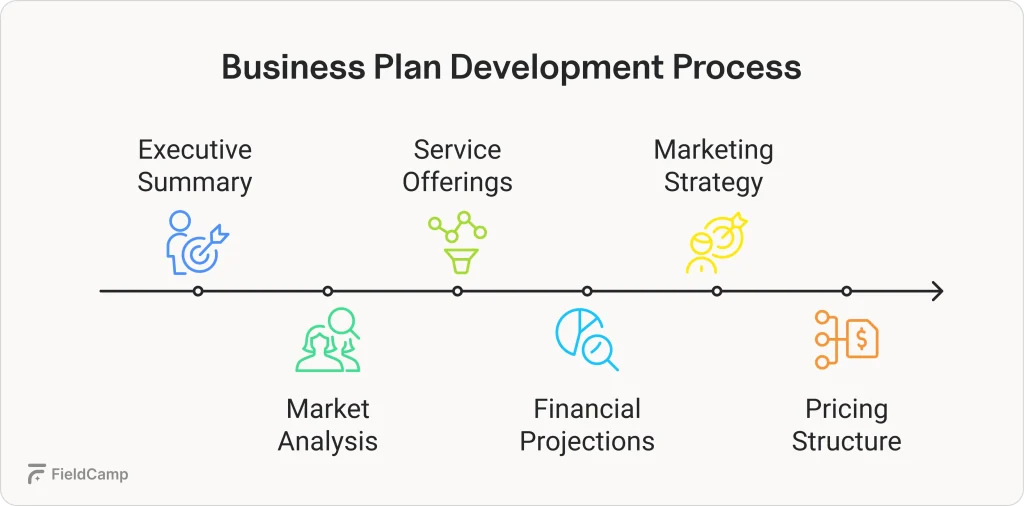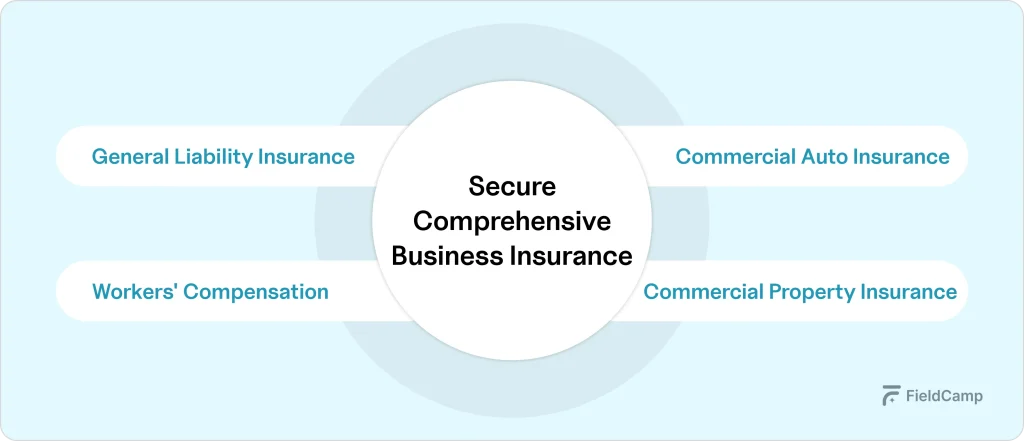The painting industry presents one of the most accessible entrepreneurial opportunities for skilled tradespeople. With homeowners constantly seeking to refresh their spaces and businesses requiring regular maintenance, the demand for professional painting services remains consistently strong.
Whether you’re drawn to the creative aspects of color theory or simply enjoy working with your hands, starting a painting business can provide both financial independence and personal satisfaction.
The average painting contractor earns approximately $21.82 per hour, and interior painting alone can increase a home’s value by up to 5%. More importantly, painting businesses require relatively low startup costs compared to other trades, making them an attractive option for aspiring business owners.
This comprehensive guide will walk you through every essential step to launch and grow your painting business successfully.
Want to explore how to start a painting business visually? Check out our YouTube video below:
1. Develop Your Painting Skills and Expertise
Before diving into business ownership, mastering the fundamentals of professional painting is crucial. The difference between amateur and professional work becomes painfully obvious to clients, and your reputation depends on delivering quality results consistently.
Essential Skills to Master:
- Surface preparation techniques, including scraping, patching, and sanding
- Proper brush and roller techniques for even coverage
- “Cutting in” paint for clean lines without tape
- Understanding different paint types: oil-based, latex, and acrylic
- Priming techniques and proper painting sequence
Specialized Skills for Higher Profits:
- Cabinet painting and refinishing
- Wallpaper removal and installation
- Epoxy floor coatings
- Commercial line striping
- High-durability commercial coatings
The most effective way to gain these skills is by working for an established painting company for 1-2 years. This hands-on experience provides invaluable insights into professional techniques, customer service, and business operations while earning income.
2. Create a Comprehensive Business Plan
A well-crafted business plan serves as your roadmap to success and is essential for securing financing. Your plan should address these key components:

Executive Summary: Brief overview of your business goals and vision
Market Analysis: Research your local competition, target demographics, and service demand in your area
Service Offerings: Define whether you’ll focus on residential, commercial, or both markets
Financial Projections: Include startup costs, ongoing expenses, and revenue forecasts for your first year
Marketing Strategy: Outline how you’ll attract and retain customers
Pricing Structure: Develop competitive rates that ensure profitability
Creating a thorough business plan forces you to think critically about every aspect of your venture and helps identify potential challenges before they become problems.
3. Handle Legal Registration and Licensing
Proper business registration establishes credibility with customers and ensures legal compliance. The process involves several important steps:
Choose Your Business Structure:
- Sole Proprietorship: Simplest option with complete control but no liability protection
- LLC (Limited Liability Company): Provides liability protection with flexible tax options
- Corporation: Offers strong liability protection but involves more complex regulations
Registration Requirements:
- Select and register a unique business name
- Obtain a federal EIN (Employer Identification Number)
- Register with state and local authorities
- Research local licensing requirements for painting contractors
Most states require business licenses costing between $75-$400 annually. Contact your local Chamber of Commerce or Small Business Administration for specific requirements in your area.
Paint Profits, Not Paperwork
Your time belongs on walls, not spreadsheets.FieldCamp takes care of CRM, scheduling, bookings, job tracking, and invoicing, so you focus on growing your painting business.
4. Secure Comprehensive Business Insurance
Insurance protects your business from devastating financial losses due to accidents, injuries, or property damage. Don’t let the cost deter you—one lawsuit could destroy an uninsured business.

Essential Coverage Types:
- General Liability Insurance: Covers accidents, property damage, and injuries on job sites
- Workers’ Compensation: Required by law when you hire employees
- Commercial Auto Insurance: Protects company vehicles and equipment transport
- Commercial Property Insurance: Covers your office, storage space, and equipment
Consider a Business Owner’s Policy (BOP) that bundles general liability, commercial property, and business income insurance for comprehensive protection at a lower cost than individual policies.
5. Set Up Financial Systems
Separating business and personal finances simplifies accounting, improves tax preparation, and establishes business credit history.

Financial Setup Steps:
- Open a dedicated business bank account
- Obtain a business credit card for equipment purchases and expenses
- Choose accounting software like QuickBooks for expense tracking and invoicing
- Consider hiring a professional accountant for tax planning and compliance
Proper financial management from day one prevents headaches during tax season and provides clear insights into your business’s profitability.
To streamline operations, many new contractors explore digital solutions like modern painting contractor software to understand how it helps track expenses, manage clients, and organize jobs more efficiently.
Read our detailed guide on what painting contractor software is and see how you can simplify workflows and grow faster.
6. Define Your Service Offerings
Focusing on specific services helps you develop expertise, streamline operations, and target marketing efforts effectively. Consider these popular painting services:
Residential Services:
- Interior painting
- Exterior painting
- Cabinet refinishing
- Wallpaper removal
- Drywall repair
- Staining and sealing
Commercial Services:
- Office building painting
- Retail space painting
- Industrial coatings
- Parking lot line striping
- Pressure washing
Start with services you’re most comfortable performing and gradually expand as you gain experience and confidence.
7. Invest in Quality Equipment
Professional results require professional tools. While startup costs for equipment range from $675-$2,000, investing in quality tools pays dividends in efficiency and results.
Essential Equipment:
- Various brush sizes for detail work
- High-quality rollers and covers
- Paint trays and liners
- Drop cloths (canvas preferred over plastic)
- Painter’s tape
- Sandpaper and scrapers
- Ladders for reach work
- Caulking gun and supplies
Advanced Equipment (as needed):
- Paint sprayers for large projects
- Pressure washers for surface preparation
- Extension poles for high ceilings
- Safety equipment, including harnesses for exterior work
Resist the temptation to buy cheap, consumer-grade tools. Professional equipment lasts longer, performs better, and ultimately saves money through improved efficiency and reduced replacement costs.
8. Develop a Smart Pricing Strategy
Proper pricing ensures profitability while remaining competitive in your market. Too many painting businesses fail because they underestimate costs and underprice their services.
Pricing Calculation Formula:
- Estimate labor hours required
- Multiply hours by your desired hourly rate
- Add material costs (paint, supplies, equipment wear)
- Include overhead expenses (insurance, vehicle costs, licensing)
- Add your desired profit margin (typically 15-25%)
Common Pricing Methods:
- Hourly rates: Best for unpredictable or repair work
- Flat project rates: Good for standard room painting
- Per square foot: Effective for large commercial projects
Research local market rates to ensure your pricing is competitive while maintaining profitability.
Beyond just setting rates, using digital tools can help maximize profitability. Learn more about the benefits of painting contractor software to simplify estimating, invoicing, and job tracking.
9. Launch Your Marketing Strategy
Effective marketing attracts customers and builds your business reputation. Start with low-cost strategies and expand as your business grows.
Build Your Brand Identity:
- Create a memorable business name and logo
- Design professional business cards and vehicle decals
- Choose consistent company colors and uniforms
- Develop a clear value proposition
Establish Online Presence:
- Create a Google Business Profile for local search visibility
- Build a simple website showcasing your services and portfolio
- Set up social media accounts (Facebook, Instagram)
- Collect and display customer reviews
Local Marketing Tactics:
- Network with real estate agents and property managers
- Join local business organizations like BNI
- Create referral programs for satisfied customers
- Use before-and-after photos to showcase your work
- Consider local advertising and community involvement
Word-of-mouth referrals remain the most powerful marketing tool for painting businesses. Focus on delivering exceptional service that customers want to share with others.
10. Scale Your Business
As demand grows, you’ll need help to handle the increased workload and expand your service area.
Hiring Options:
- Subcontractors: Independent contractors who supply their tools and handle specific projects
- Employees: Full-time team members you train and develop for consistent quality
Subcontractors offer flexibility and reduced overhead, while employees provide consistency and company culture development. Many successful painting businesses use a combination of both.
Growth Strategies:
- Invest in painting business management software for scheduling and invoicing
- Develop standard operating procedures for consistency
- Focus on customer retention through excellent service
- Expand service offerings based on market demand
- Consider multiple locations as you gain experience
Helpful Guide:
As you expand, understanding how painting contractor software works can show you how scheduling, dispatching, and invoicing can be automated to save hours each week.
Essential Startup Costs Breakdown
Planning your budget accurately prevents cash flow problems during your first year:
- Business registration and licensing: $75-$400
- Insurance (first year): $500-$1,500
- Basic equipment and tools: $675-$2,000
- Vehicle (if needed): $10,000-$30,000
- Business software: $400 annually
- Marketing and branding: $150-$500
- Safety gear and uniforms: $100-$300
Total estimated startup costs: $3,000-$15,000 (excluding vehicle)
Common Mistakes to Avoid
Learning from others’ mistakes saves time and money:
- Underpricing services: Leads to cash flow problems and business failure
- Skipping insurance: One accident can bankrupt an uninsured business
- Using cheap tools: Costs more in the long run through poor results and frequent replacement
- Neglecting surface preparation: Proper prep work is essential for lasting results
- Poor customer communication: Clear communication prevents misunderstandings and disputes
- Expanding too quickly: Grow at a sustainable pace to maintain quality
Conclusion
Starting a painting business offers an excellent opportunity for skilled tradespeople to build a profitable, fulfilling career. Success requires more than painting skills—you need business acumen, proper planning, and dedication to customer service.
Focus on developing professional skills, creating solid business foundations, and delivering exceptional results that generate positive word-of-mouth referrals. With the right approach, your painting business can provide both financial independence and the satisfaction of transforming spaces for satisfied customers.
Remember that building a successful business takes time. Start small, reinvest profits into growth, and maintain high standards as you expand. The painting industry rewards those who combine technical expertise with professional business practices.
Ready to start your painting business journey? Begin by developing your skills and creating a comprehensive business plan. Your future as a successful painting contractor starts with that first brushstroke of preparation.
From Brushstrokes to Business
Your talent transforms spaces; FieldCamp transforms your workflow. From CRM and scheduling to job tracking and invoices, everything runs in one place, so your business grows while you paint.
Frequently Asked Questions
How much does it cost to start a painting business?
Starting a painting business typically costs between $3,000–$15,000. Expenses include licensing, insurance, equipment, and marketing. Costs vary depending on whether you already own tools or need a vehicle for transport.
Do I need a license to start a painting business?
Yes, most states require a painting contractor license and business registration. Licensing costs range from $75–$400 annually. Always check with your local Chamber of Commerce or Small Business Administration for exact requirements.
What kind of insurance should a painting business have?
Painting businesses should carry general liability insurance, workers’ compensation (if hiring), commercial auto, and property insurance. Many owners choose a Business Owner’s Policy (BOP) that bundles multiple protections at a lower cost.
How can I get customers for my new painting business?
Start by building a strong online presence with a Google Business Profile, website, and social media. Collect reviews, showcase before-and-after photos, and network locally. Word-of-mouth referrals are your most powerful tool for steady growth.
How can I manage jobs and client scheduling more efficiently?
Instead of relying on spreadsheets or manual tracking, use field service software like FieldCamp. It helps manage painting jobs, assign teams, send invoices, and track payments—saving time and improving client satisfaction as your business grows.

